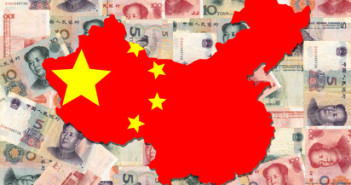Markets are falling upward this morning, after data was released showing that China’s manufacturing sector had weakened for the fifth consecutive month. Traders bought China-sensitive assets in the belief that policymakers would soon act to spur growth in the world’s second largest economy after HSBC’s flash purchasing manager index slipped to 48.1 – well below the 50 mark that indicates expansion. As investors position ahead of possible stimulus spending, commodities are seeing inflows, while Asian equity markets are up broadly.Â
The euro is up against the dollar, bolstered by evidence that the performance gap between Germany and France is beginning to narrow. Germany released very strong purchasing manager numbers at 53.8 but disappointed against expectations. In contrast, France destroyed bearish forecasts with a rebound into plus-50 territory. The German economic powerhouse continues to outperform its Gallic counterpart, but the positive French result is likely to ease strains between the two largest euro-bloc economies.Â
Across the Channel, the pound is trading near a four-month low after last week’s release of minutes for the Bank of England’s March policy meeting. Officials voted unanimously to keep interest rates at half a percent, exacerbating widening differentials against the increasingly hawkish Federal Reserve.Â
The loonie remains in the cold, with investors ignoring commodity price gains and higher-than-expected inflation data to focus on the Bank of Canada’s dovish outlook. Although price data released last week has helped to stall the currency’s descent beyond the 1.1300 threshold, greenback buyers are clearly picking up nickels in front of a steamroller at this point – meaning that effective risk management strategies are more important than ever. Â
Getting Interesting:
Herbert Stein, an economist under the Nixon administration once said “if something cannot go on forever, it will stopâ€. This reasoning has clearly taken hold in the financial world.Â
Last week, when Janet Yellen casually said that rising inflation could mean that interest rate hikes would begin as little as six months after quantitative easing comes to an end, the currency markets were thrown into turmoil. The US dollar surged against the majors, the euro plummeted almost two cents in a matter of minutes, and the Canadian dollar hit a four and a half year low. Many participants decided that today’s low yield environment was doomed, and began to position for a steepening yield curve.Â
We would suggest that while rates will inevitably move up at some point, the current hysteria may be overdone – meaning that the dollar’s gains may become stretched in the coming months.Â
Technological change is propelling global productivity levels upward, increasing the quantity and quality of products available to consumers. Trade barriers and real shipping costs continue to fall, lowering the costs associated with moving goods between countries.
At the same time, aging baby boomers are facing a form of demographic desperation, forcing them to compete with each other for profits in markets that are already oversaturated with capital. While this has translated into sharp gains in housing markets, cash inflows have the opposite effect on fixed income markets, driving yields downward.Â
In essence, inflationary pressures remain extremely benign, with unique historical circumstances acting to keep prices under control. If this translates into weaker-than-expected data over the next year, the dollar’s recent gains will be vulnerable to corrections.
Further reading:
GBP/USD: Trading the British CPI
Germany and France



